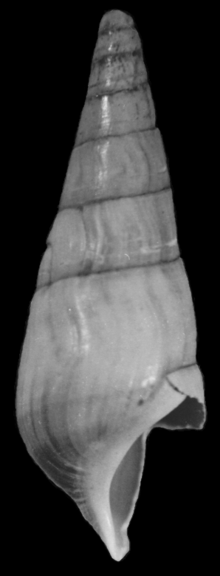- Melanopsidae
-
Melanopsidae 
Apertural view of a damaged shell of Fagotia wuesti Scientific classification Kingdom: Animalia Phylum: Mollusca Class: Gastropoda (unranked): clade Caenogastropoda
clade Sorbeoconcha
Superfamily: Cerithioidea Family: Melanopsidae
H. Adams & A. Adams, 1854[1]Diversity about 25-50 freshwater species[2] Synonyms Stomatopsinae Stache, 1889[3]
Amphimelaniinae P. Fischer & Crosse, 1891[4]
Fagotiinae Starobogatov, 1992[5]Melanopsidae, common name melanopsids, is a family of freshwater gastropods in the clade Sorbeoconcha.[6] Species in this family are native to southern and eastern Europe, northern Africa, parts of the Middle East, New Zealand, and freshwater streams of some large South Pacific islands.[7]
These snails first appeared in the Late Cretaceous and are closely related to Potamididae. As well as unidirectional evolutionary change from one species to the next over time, the process of hybridization plays a major role in the appearance of new Melanopsidae species.[8]
According to the taxonomy of the Gastropoda by Bouchet & Rocroi (2005) the family Melanopsidae has no subfamilies.[6]
Genera
Genera in the family Melanopsidae include:
- Amphimelania P. Fischer, 1885[6][9]
- Esperiana Bourguignat, 1877[10]
- Fagotia Bourguignat, 1884[6][9]
- Holandriana Bourguignat, 1884[10]
- Melanopsis Férussac, 1807 - type genus of the family Melanopsidae[6][10][9]
- † Pseudobellardia Cox, 1931[9]
- † Stomatopsis Stache, 1871[9][6]
- † Stylospirula Rovereto, 1899[9]
- Zemelanopsis Finlay, 1927[13]
- Zemelanopsis trifasciata (Gray, 1843)[13]
References
- ^ Adams H. & Adams A. (1854). The genera of Recent Mollusca 1: 309.
- ^ Strong E. E., Gargominy O., Ponder W. F. & Bouchet P. (2008). "Global Diversity of Gastropods (Gastropoda; Mollusca) in Freshwater". Hydrobiologia 595: 149-166. http://hdl.handle.net/10088/7390 doi:10.1007/s10750-007-9012-6.
- ^ Stache (1889). Abhandlungen der Kaiserlich-Königlichen Geologischen Reichsanstalt 13(1): 90.
- ^ Fischer P. & Crosse (1891). Mission scientifique au Mexique et dans l'Amérique Centrale. Recherches zoologiques (7)2(12): 312.
- ^ Starobogatov (1992). In: Starobogatov, Alexenko & Levina Biulleten' Moskovskogo Obshchestva Ispytatelei Prirody, Otdel Biologicheskii new ser. 97(3): 58.
- ^ a b c d e f Bouchet P., Rocroi J.-P., Frýda J., Hausdorf B., Ponder W., Valdés Á. & Warén A. (2005). "Classification and nomenclator of gastropod families". Malacologia: International Journal of Malacology (Hackenheim, Germany: ConchBooks) 47 (1-2): 1–397. ISBN 3925919724. ISSN 0076-2997. http://www.archive.org/details/malacologia47122005inst.
- ^ Banarescu P. (1990). Zoogeography of Fresh Waters Vol. 1, General Distribution and Dispersal of Freshwater Animals. AULA-Verlag Wiesbaden.
- ^ Bandel K. (2000). "Speciation among the Melanopsidae (Caenogastropoda). Special emphasis to the Melanopsidae of the Pannonian Lake at Pontian time (Late Miocene) and the Pleistocene and Recent of Jordan". Mitt. Geol.-Paläont. Inst. Univ. Hamburg, Heft 84.
- ^ a b c d e f "Melanopsidae". The Paleobiology database, accessed 26 June 2011.
- ^ a b c d Glöer P. (2002). Die Süßwassergastropoden Nord- und Mitteleuropas. Die Tierwelt Deutschlands, ConchBooks, Hackenheim, 326 pp., ISBN 3-925919-60-0, page 190-194.
- ^ "Species summary for Holandriana holandrii". AnimalBase, last modified 30 August 2010, accessed 26 June 2011.
- ^ "Amphimelania holandrii (C. Pfeiffer 1828)". Fauna Europaea, accessed 26 June 2011.
- ^ a b Bandel K. (2006). "Families of the Cerithioidea and related superfamilies (Palaeo-Caenogastropoda; Mollusca) from the Triassic to the Recent characterized by protoconch morphology - including the description of new taxa". Freiberger Forschungshefte C 511: 59-138. PDF.
External links
- Melanopsidae at National Center for Biotechnology Information (NCBI) website.
This Melanopsidae-related article is a stub. You can help Wikipedia by expanding it.
